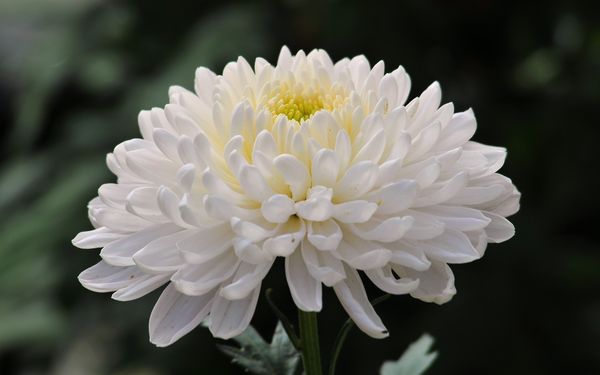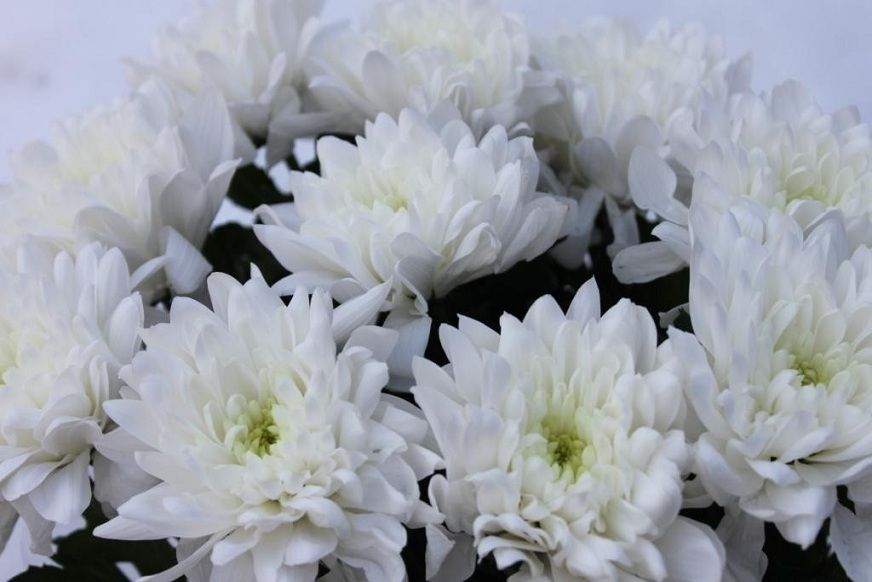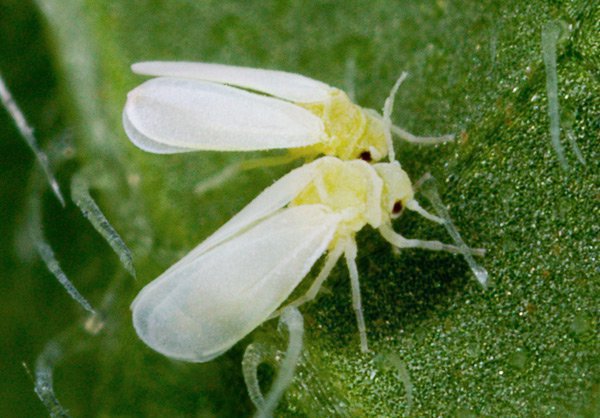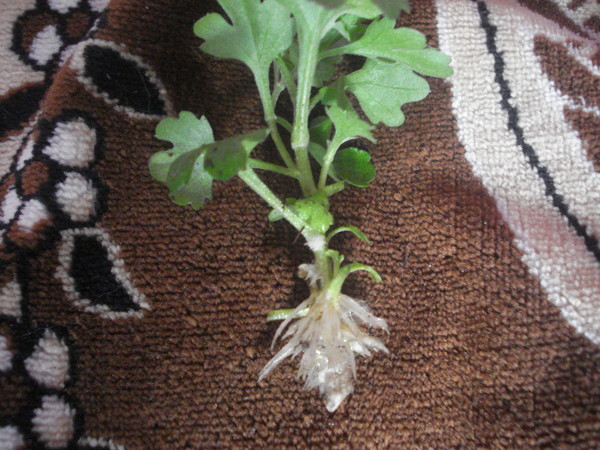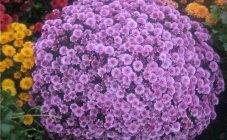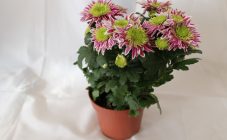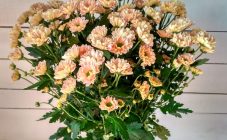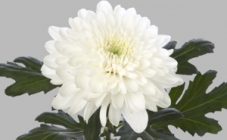Content:
Chrysanthemum is a beautiful and unusual flower, which is native to Southeast Asia, although it is more often found in China and Japan, where the plant is a national symbol.
Bush chrysanthemum Baltica is popular among gardeners. Its advantages are luxurious large buds, as well as simple agricultural technology. The distinctive features of the Baltic chrysanthemum and the rules of caring for it will be discussed later.
General characteristics of the flower
Chrysanthemum bush belongs to the Asteraceae or Asteraceae family. Its height reaches from 30 to 150 cm. Translated from Greek, chrysanthemum means "flower-sun". She got this name due to the beautiful bright inflorescences.
Chrysanthemum buds have a lot of colors: pink, yellow, cream, white and others. About 650 different garden varieties are cultivated, which differ in the size of the bush, the color and shape of the petals. Depending on the diameter, such flower varieties are distinguished: small-flowered, medium-flowered, large-flowered.
The plant is not difficult to grow and propagate. It grows well up to 5 years in one place. All types of chrysanthemums are frost-resistant. Some chrysanthemums begin to bloom at the end of July, but most varieties of the plant bloom only from the second half of August. There are late varieties, their flowering period lasts until the end of November.
Description of the variety Baltika white bush
The chrysanthemum Baltica was brought to Europe by the Dutch. This culture became widespread only 100 years later, becoming an ornamental garden flower. This variety has varieties that differ in the color of the buds (White, Yellow, Pink, Lime).
Chrysanthemum Baltika white is a perennial herb that has large double flowers. The color of its petals is mostly dazzling white, but sometimes they can be interspersed with green from the base.
It can be grown both outdoors and at home on a windowsill. The diameter of the buds growing in the garden is 10-25 cm, at home the diameter of the bud is no more than 12 cm. The inflorescences are in the shape of a ball and consist of large flowers that are shaped like tongues. Collected flowers in tight rosettes.
The roots of the plant are thickened, branched, located close to the surface of the earth. The leaves are dark green, pinnate, trifoliate, divided into lobes. The upper part of the leaf is fleecy and the lower part is smooth.
Chrysanthemum grown outdoors reaches 90 cm in height. If it is grown at home, then up to 30 cm. At home, the plant is grown as an annual.
Chrysanthemum Baltika blooms in September. It belongs to the early varieties. Medium varieties bloom in October, and late ones in November.
One stem can have from one to three buds. They have a delicate honey scent that attracts bees. A bush with fragrant buds in the open field begins to bloom from the second half of September.Since chrysanthemum Baltika is a hardy and cold-resistant plant, its flowering in the open field continues until frost, on average about 30 days. By creating artificial light for the plant indoors, flowering can last from 6 to 8 months.
Features of growing varieties Baltika white bush
Chrysanthemum spray Baltika white loves light.
Soil and fertilizing
It is important to loosen the soil every week, hilling the bushes a little. So that the soil is not dry, the layer of soil that is near the trunk of the plant is covered with sawdust, foliage or grass.
The plant likes loose and nutritious soil. If the land is not fertile, then it must be fertilized with peat or rotted manure. It is useful to add fertilizing to the soil once every 14 days (mineral alternates with organic). Such fertilizers promote lush flowering. Fertilization with organic matter is done as follows: pour 3 buckets of water into a bucket of mullein and let it stand for three days. Then 1 liter of the resulting infusion is diluted with 10 liters of water. The solution is mixed and poured under the bushes. It is important to carry out such an event during the rain so that the earth is moist.
To accelerate the growth of the bush, fertilizers containing nitrogen are used. During budding, potassium and phosphorus substances are added. When the chrysanthemum has bloomed, it is no longer necessary to feed it. It is important to land it on a cool day. After planting in the ground, pinch the bush, shortening all the stems. 21 days after planting the plant, it is pinched again, breaking off part of the stems with 2-3 nodes on top.
Watering
It is better to water it 2-3 times a week with rain or settled water (always at the root). Particular attention is needed for chrysanthemums during the scorching sun. The delicate leaves of the plant can “burn” in the sun. In the future, this negatively affects flowering. In a hot period, it is necessary to water the bush more often and slightly shade the bush from the sun. Sprinkle the leaves with filtered or warm spring water.
Pruning
Tall bushes must be tied up so that they do not break under the weight of the buds. It is also necessary to remove diseased shoots and old leaves from the plant, and trim unnecessary shoots. To make the bud as large as possible, the first inflorescence that appears must be removed. If there is a need to accelerate plant growth, then the upper part of the stem is pruned.
Diseases and pests
Bush chrysanthemum is often attacked by aphids, worms or powdery mildew. To combat parasites and diseases, there are many biological and chemical preparations, folk remedies are also used in the form of soap solutions, etc. If the plant is properly looked after and preventive measures are taken in a timely manner, then difficulties in growing can be avoided.
Preparing for winter
A flower that grows in a pot is prepared for a dormant period. To do this, the above-ground organs are removed from the plant, the container with the rhizome is placed in a dark place with an air temperature of + 10-15 degrees. When spring comes, a plant that has rested over the winter and has sprouted fresh young twigs is planted in a new land.
For the winter, bushes that grow in open ground must be covered. After the chrysanthemum bush has bloomed, all the stems are cut to the ground, and he himself hides, and then takes cover. The plant can be mulched with fallen leaves, but it is better to dig it up and keep it in a room with a temperature of up to +5 degrees, since frost is dangerous for this variety.When storing a plant indoors, it sometimes needs to be watered so that the earthen lump does not dry out.
Reproduction
For the reproduction of chrysanthemums of the Baltic, several methods are used:
- planting seeds;
- cuttings: even a sprout from a bouquet, if planted in the ground, takes root well and very soon leaves appear on it;
- division of the bush: the plant is dug up, divided with roots into parts and seated separately from each other.
Propagation by cuttings is the easiest of the ways. The plant from which the cuttings will be separated must be selected when it is still in bloom. The largest and most attractive healthy buds are selected. The shoots are separated from the "parent" and placed in a box with prepared soil (perlite with the addition of peat or turf soil is suitable). The cuttings are buried into the substrate by no more than 2 cm. The plant should be in a room with a temperature of + 3-5 degrees for 3-4 weeks.
After the cutting takes root, the plant can be transplanted to its permanent habitat.
Benefits of the variety
Advantages over other varieties:
- endurance;
- long flowering period until frost;
- cut flowers in a vase do not fade and remain fresh for about 3 weeks.
- unlike other varieties, it has large double flowers of various colors.
- the ability to grow a flower both at home and in the garden.
Chrysanthemum Baltika has many advantages and practically no disadvantages. A flower grown in a garden will delight its owners with luxurious inflorescences every year, and in return will require just a little care.
